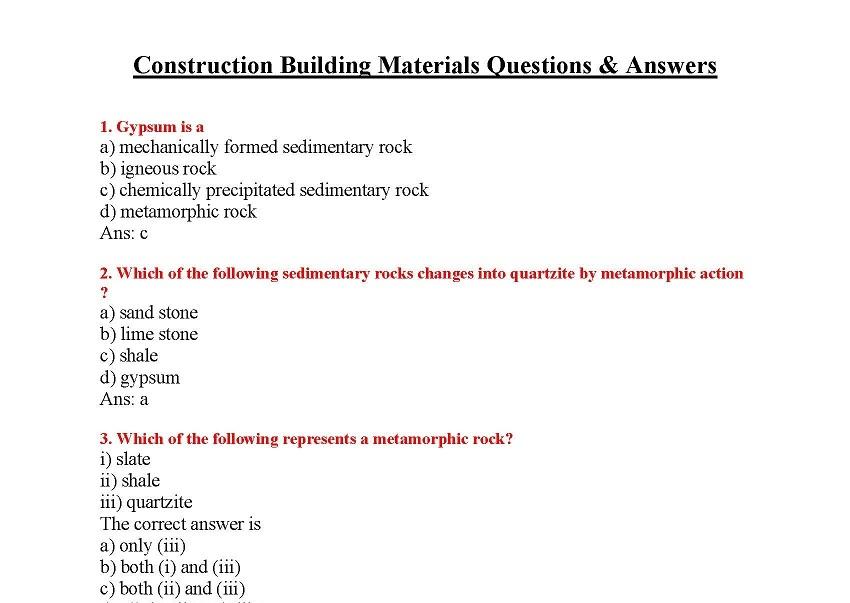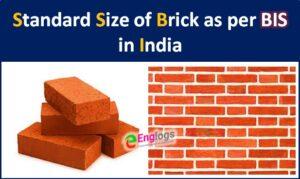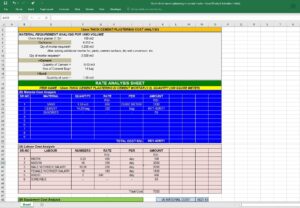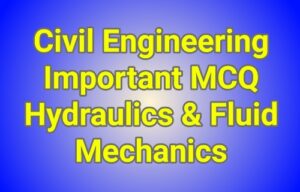Building Materials Civil – Engineering Questions & Answers Part-2
1. The process of mixing clay, water and other ingredients to make brick is known as
a) kneading
b) moulding
c) pugging
d) drying
Ans: a
2. Advantage of a clamp compared to a kiln for burning bricks is that
a) it takes less time for burning
b) it gives more output of first class bricks
c) it has less initial cost
d) it is suitable when bricks are required in large numbers
Ans: c
3. The internal size of mould used in brick preparation is
a) equal to the size of a fully burnt brick
b) smaller than the size of a fully burnt brick
c) greater than the size of a fully burnt brick
d) none of the above
Ans: c
4. Pug mill is used for
a) preparation of clay
b) moulding of clay
c) drying of bricks
d) burning of bricks
Ans: a
5. Which of the following bricks are used for lining of furnaces ?
a) overburnt bricks
b) underburnt bricks
c) refractory bricks
d) first class bricks
Ans: c
6. The frog of the brick in a brick masonry is generally kept on
a) bottom face
b) top face
c) shorter side
d) longer side
Ans: b
7. Number of bricks required for one cubic metre of brick masonry is
a) 400
b) 450
c) 500
d) 550
Ans: c
8. Glazing is used to make earthenware
a) hard
b) soft
c) porous
d) impervious
Ans: d
9. Quick lime is
a) calcium carbonate
b) calcium oxide
c) calcium hydroxide
d) none of the above
Ans: b
10. Quick lime is
i) slow in setting
ii) rapid in slacking
iii) good in strength The correct answer is
a) only (i)
b) only (ii)
c) both (i) and (ii)
d) both (ii) and (iii)
Ans: c
11. Assertion A : Pure lime takes a long time to develop adequate strength.
Reason R : Pure lime has slow hardening characteristics.
Select your answer according to the coding system given below :
a) Both A and R are true and R is correct explanation of A.
b) Both A and R are true and R is not a correct explanation of A.
c) A is true but R is false.
d) A is false but R is true.
Ans: a
12. Hydraulic lime is obtained by
a) burning of lime stone
b) burning of kankar
c) adding water to quick lime
d) calcination of pure clay
Ans: b
13. The main constituent which imparts hydraulicity to hydraulic lime is
a) calcium oxide
b) silica
c) clay
d) water
Ans: c
14. Study the following statements.
i) Hydraulic lime is suitable for white washing,
ii) Fat lime is suitable for whitewashing,
iii) Hydraulic lime is suitable for making mortar,
iv) Fat lime is suitable for making mortar.
The correct answer is
a) (i) and (iv)
b) (ii) and (iii)
c) (i) and (ii)
d) (iii) and (iv)
Ans: b
15. The main ingredients of Portland cement are
a) lime and silica
b) lime and alumina
c) silica and alumina
d) lime and iron
Ans: a
16. The constituent of cement which is responsible for all the undesirable properties of cement is
a) dicalcium silicate
b) tricalcium silicate
c) tricalcium aluminate
d) tetra calcium alumino ferrite
Ans: c
17. Le Chatelier’s device is used for determining the
a) setting time of cement
b) soundness of cement
c) tensile strength of cement
d) compressive strength of cement
Ans: b
Building Materials Civil – Engineering Questions Answers
18. The main constituent of cement which is responsible for initial setting of cement is
a) dicalcium silicate
b) tricalcium silicate
c) tricalcium aluminate
d) all of the above
Ans: c
19. The initial setting time for ordinary Portland cement as per IS specifications should not be less than
a) 10 minutes
b) 30 minutes
c) 60 minutes
d) 600 minutes
Ans: b
20. As per IS specifications, the maximum final setting time for ordinary Portland cement should be
a) 30 minutes
b) 1 hour
c) 6 hours
d) 10 hours
Ans: d
21. For testing compressive strength of cement, the size of cube used is
a) 50 mm
b) 70.6 mm
c) 100 mm
d) 150 mm
Ans: a
22. The normal consistency of ordinary Portland cement is about
a) 10%
b) 20%
c) 30%
d) 40%
Ans: c
23. Early attainment of strength in rapid hardening cement is mainly due to
a) gypsum
b) finer grinding
c) tricalcium silicate
d) tricalcium aluminate
Ans: b
24. After storage, the strength of cement
a) decreases
b) increases
c) remains same
d) may increase or decrease
Ans: a
25. According to IS specifications, the compressive strength of ordinary portland cement after three days should not be less than
a) 7 MPa
b) 11.5 MPa
c) 16 MPa
d) 21 MPa
Ans: c
26. Addition of pozzolana to ordinary Portland cement increases
a) bleeding
b) shrinkage
c) permeability
d) heat of hydration
Ans: b
27. Gypsum consists of
a) H2S and C02
b) CaS04 and H20
c) Lime and H20
d) C02 and calcium
Ans: b
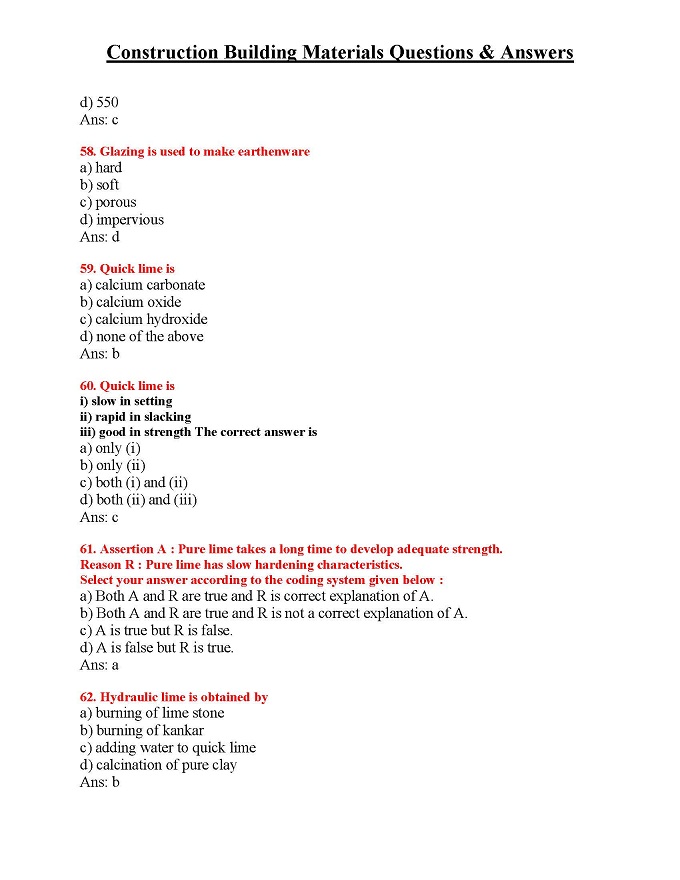
28. For testing compressive and tensile strength of cement, the cement mortar is made by mixing cement and standard sand in the proportions of
a) 1:2
b) 1:3
c) 1:4
d) 1:6
Ans: b
29. The slump recommended for mass concrete is about
a) 25 mm to 50 mm
b) 50 mm to 100 mm
c) 100 mm to 125 mm
d) 125 mm to 150 mm
Ans: a
30. With increase in moisture content, the bulking of sand
a) increases
b) decreases
c) first increases to a certain maximum value and then decreases
d) first decreases to a certain minimum value and then increases
Ans: c
31. Which of the following cements is suitable for use in massive concrete structures such as large dams ?
a) ordinary Portland cement
b) low heat cement
c) rapid hardening cement
d) sulphate resisting cement
Ans: b
32. Proper amount of entrained air in concrete results in
i) better workability
ii) better resistance to freezing and thawing
iii) lesser workability
iv) less resistance to freezing and thawing The correct answer is
a) (i) and (ii)
b) (i)and(iv)
c) (ii) and (iii)
d) (iii) and (iv)
Ans: a
33. The most common admixture which is used to accelerate the initial set of concrete is
a) gypsum
b) calcium chloride
c) calcium carbonate
d) none of the above
Ans: b
34. The maximum quantity of calcium chloride used as an accelerator in cement in percentage by weight of cement is
a) 1
b) 2
c) 3
d) 4
Ans: b
35. The basic purpose of a retarder in concrete is
a) to increase the initial setting time of cement paste in concrete
b) to decrease the initial setting time of cement paste in concrete
c) to render the concrete more water tight
d) to improve the workability of concrete mix
Ans: a
36. Which of the following cements contains maximum percentage of dicalcium silicate?
a) ordinary Portland cement
b) low heat cement
c) rapid hardening cement
d) sulphate resisting cement
Ans: b
37. The most commonly used retarder in cement is
a) gypsum
b) calcium chloride
c) calcium carbonate
d) none of the above
Ans: a
38. Three basic raw materials which are needed in large quantities for production of steel are
a) iron ore, coal and sulphur
b) iron ore, carbon and sulphur
c) iron ore, coal and lime stone
d) iron ore, carbon and lime stone
Ans: c
39. Compared to mild steel, cast iron has
i) high compressive strength
ii) high tensile strength
iii) low compressive strength
iv) low tensile strength
The correct answer is
a) (i) and (ii)
b) (ii) and (iii)
c) (iii) and (iv)
d) (i)and(iv)
Ans: d
40. Which of the following gradients exerts maximum influence on properties of steel?
a) iron
b) carbon
c) manganese
d) sulphur
Ans: b
41. Which of the following is the purest form of iron ?
a) cast iron
b) wrought iron
c) mild steel
d) high carbon steel
Ans: b
42. The ultimate tensile strength of structural mild steel is about
a) 160N/mm2
b) 260N/mm2
c) 420 N/mm2
d) 520 N/mm2
Ans: c
43. Percentage of carbon content in mild steel is
a) less than 0.25
b) between 0.25 and 0.7
c) between 0.7 and 1.5
d) greater than 1.5
Ans: a
44. Which of the following stresses is used for identifying the quality of structural steel ?
a) ultimate stress
b) yield stress
c) proof stress
d) none of the above
Ans: b
45. The ratio of the thickness of web to that of flange of steel rolled structural beams and channels is
a) less than 1
b) equal to 1
c) greater than 1
d) less than 1 in beams but greater than 1 in channels
Ans: a
46. Paints with white lead base are suitable for painting of
a) wood work
b) iron work
c) both wood work and iron work
d) none of the above
Ans: a
47. Assertion A : Paints with white lead base are not recommended for painting of iron works.
Reason R : Paints with white lead base do not check rusting of iron.
Select your answer according to the coding system given below :
a) Both A and R are true and, R is the correct explanation of A.
b) Both A and R are true but R is not the correct explanation of A
c) A is true but R is false
d) A is false but R is true
Ans: a
48. The amount of water used for one kg of distemper is
a) 0.2 liter
b) 0.4 liter
c) 0.6 liter
d) 0.8 liter
Ans: c
49. The vehicle used in case of enamel paints is usually
a) linseed oil
b) water
c) varnish
d) none of the above
Ans: c
50. Assertion A : Normally turpentine oil is recommended as thinner for indoorpainting.
Reason R : Turpentine oil is costlier than other thinners.
Select your answer according to the coding system given below :
a) Both A and R are true and R is the correct explanation of A.
b) Both A and R are true but R is not the correct explanation of A.
c) A is true but R is false.
d) A is false but R is true.
Ans: b
You may also like:
- ARAMCO :: CBT QA/QC – Instrumentation Inspector Qualification Guideline
- PIPING Inspector Qualification Guideline Vol-2
- Saudi Aramco Cbt Exam Questions and Answers
- CBT EXAM E-BOOKS
- QA/QC ELECTRICAL Inspector Question & Answer Handbooks
- QA/QC E-books Category
- WELDING PROCEDURES (WPS) Neptune Energy Netherlands
- What is Pipe Rack?
- Building Materials Civil – Engineering Questions Answers Part-1

